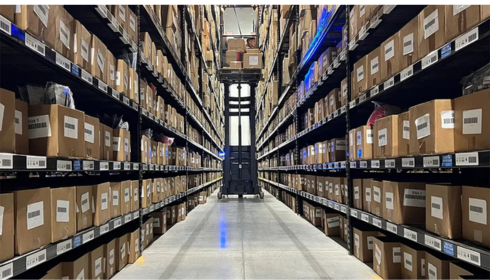In the realm of warehouse organization, selecting the appropriate shelving system is paramount. In this article, ‘Choosing the Right Warehouse Shelving: Insights from One Stop Pallet Racking’, we delve into the crucial considerations and expert advice offered by industry leader One Stop Pallet Racking to optimize storage efficiency and streamline operations.
Understanding Your Warehouse Needs
Understanding your warehouse needs is crucial for the efficient operation of your business. This involves evaluating various factors such as the type of products you store, the volume of inventory, and the frequency of shipments. By analyzing these aspects, you can determine the required storage space, layout, and equipment needed to maximize productivity and minimize operational costs. Additionally, understanding your warehouse needs involves considering factors like handling requirements, safety regulations, and potential growth projections to ensure that your warehouse can adapt to future changes in your business.
Furthermore, understanding your warehouse needs involves evaluating the technology and software solutions that can streamline your warehouse operations. Implementing warehouse management systems (WMS), inventory tracking systems, and automated material handling equipment can improve accuracy, efficiency, and overall productivity. By harnessing the power of technology, you can optimize inventory management, reduce errors, and enhance order fulfillment processes. Understanding your warehouse needs also means staying informed about industry trends and best practices to continuously improve your warehouse operations and stay ahead of the competition.
One Stop Pallet Racking offers comprehensive solutions tailored to meet diverse warehouse needs. Their expertise in design, installation, and maintenance, coupled with top-quality pallet racking and storage systems, ensures optimized space utilization and enhanced operational efficiency, empowering businesses to thrive in a competitive market.
Types of Warehouse Shelving Systems
There are several types of warehouse shelving systems designed to maximize storage efficiency and organization within a warehouse setting. One common type is pallet racking, which consists of upright frames and horizontal beams to support pallets of goods. Pallet racking is ideal for storing large quantities of goods and provides accessibility for forklifts to easily load and unload pallets. Another type is cantilever racking, which is suitable for storing long and bulky items such as lumber, pipes, and furniture. Cantilever racking features arms that extend outward from vertical columns, allowing for easy access to items without the obstruction of vertical beams.
Another popular type of warehouse shelving system is mezzanine shelving, which involves creating a raised platform above the warehouse floor to increase storage capacity. Mezzanine shelving is versatile and can be customized to fit the specific needs of a warehouse, such as adding stairs, handrails, and conveyor systems. Additionally, wire shelving systems are commonly used for storing smaller items and provide good visibility and accessibility. Wire shelving is lightweight, easy to assemble, and adjustable to accommodate varying storage needs. Overall, choosing the right type of warehouse shelving system is crucial for optimizing space utilization and improving overall warehouse efficiency.
Factors to Consider When Selecting Warehouse Shelving
When selecting warehouse shelving, there are several key factors to consider to ensure efficient storage solutions. Firstly, it is important to assess the type of inventory being stored, as this will determine the size, weight capacity, and configuration of the shelving needed. Different types of products may require specialized shelving such as pallet racks for heavy items or boltless shelving for smaller items. Understanding the inventory will also help determine the layout and accessibility needed for efficient picking and restocking processes.
Another important factor to consider when selecting warehouse shelving is the available space and layout of the warehouse. It is crucial to maximize the use of vertical space to optimize storage capacity while maintaining accessibility and safety. Factors such as ceiling height, aisle width, and overall floor plan need to be taken into account when choosing the appropriate shelving system. Additionally, considering future growth and flexibility in the layout is essential to accommodate changes in inventory and operational needs. By evaluating these factors, businesses can select warehouse shelving that is tailored to their specific requirements and enhances overall efficiency and productivity.
Benefits of Customized Pallet Racking Solutions
Customized pallet racking solutions offer a multitude of benefits for businesses looking to maximize their storage efficiency. One significant advantage is the ability to tailor the racking system to suit the specific needs of the warehouse space. This customization can include adjusting the height, width, and depth of the racks to optimize the use of available space, ensuring that every square foot is utilized efficiently. By customizing the pallet racking, businesses can create a layout that accommodates their unique inventory requirements, allowing for easy access to goods while maintaining a well-organized storage environment. This level of customization can lead to increased productivity and streamlined operations, as employees can quickly locate and retrieve items, reducing picking times and improving overall workflow.
Another key benefit of customized pallet racking solutions is the potential for cost savings in the long run. By designing a racking system that maximizes storage capacity and accessibility, businesses can reduce the need for additional storage space or facility expansion. This can result in significant savings on real estate costs, as well as lower maintenance expenses associated with managing larger warehouse spaces. Furthermore, customized pallet racking can help prevent damage to inventory by providing secure storage for goods of various sizes and weights. By investing in a tailored racking system, businesses can improve inventory management practices, minimize product damage, and ultimately enhance their bottom line through improved operational efficiency and cost-effectiveness.
Warehouse shelving options provided by One Stop Pallet Racking offer flexibility and scalability essential for dynamic business needs. Their solutions not only enhance space utilization but also integrate seamlessly with existing systems, ensuring businesses achieve optimal storage efficiency while adapting to future growth and operational changes.
Maximizing Storage Space Efficiency
Maximizing storage space efficiency is crucial for organizations looking to optimize their operations and reduce costs. One effective strategy is to utilize vertical space by installing tall shelves or racks to make the most of the available height in a warehouse or storage facility. This approach not only increases storage capacity but also ensures easy access to items stored at different levels. Implementing a labeling and organization system can further enhance efficiency by allowing for quick identification and retrieval of items, reducing the time spent searching for specific products. Additionally, utilizing specialized storage solutions such as stackable bins, drawer units, or pallet racking systems can help maximize space utilization and streamline inventory management processes.
Another key aspect of maximizing storage space efficiency is conducting regular audits and inventory assessments to identify underutilized spaces or inefficient storage layouts. By analyzing inventory turnover rates and storage needs, organizations can reconfigure their storage systems to better align with their operational requirements. Implementing dynamic storage solutions such as mobile shelving units or mezzanine platforms can help optimize space utilization and adapt to changing storage needs over time. Furthermore, investing in technology such as warehouse management systems or automated storage and retrieval systems can improve inventory accuracy, enhance picking efficiency, and ultimately maximize storage space utilization for improved operational productivity.
Safety Considerations for Warehouse Shelving
Safety considerations for warehouse shelving are crucial to prevent accidents and injuries in the workplace. One key aspect to consider is the weight capacity of the shelving units. It is essential to adhere to the manufacturer’s guidelines regarding the maximum weight each shelf can hold. Overloading shelves can lead to collapses, endangering employees and damaging goods. Regular inspections should be conducted to ensure that the shelving units are not bearing more weight than they can handle. Additionally, organizing heavy items on lower shelves and lighter items on higher shelves can help distribute weight evenly and prevent top-heavy shelving units from tipping over.
Another important safety consideration for warehouse shelving is proper installation and maintenance. Shelving units should be securely anchored to the floor or walls to prevent them from toppling over. Regular inspections should be carried out to check for any signs of wear and tear, such as rust, bent beams, or loose bolts. Any damaged shelving should be repaired or replaced immediately to avoid accidents. Employees should also be trained on how to safely load and unload items from the shelves to prevent injuries. By prioritizing weight capacity limits, proper installation, regular maintenance, and employee training, warehouses can create a safe working environment for their staff.
Durability and Longevity of Shelving Materials
Durability and longevity are critical factors to consider when selecting shelving materials for various applications. Metal shelving, such as steel or aluminum, is highly durable and can withstand heavy loads without bending or warping. These materials are also resistant to corrosion and moisture, making them suitable for use in environments with high levels of humidity or exposure to water. Metal shelving is known for its longevity, as it can last for decades with minimal maintenance, making it a cost-effective option in the long run.
On the other hand, wood shelving, particularly hardwoods like oak or maple, offer a more natural and aesthetically pleasing option. While wood may not be as resistant to heavy loads as metal, it is still quite durable and can hold up well over time when properly cared for. Wood shelving can be sanded, refinished, or painted to extend its lifespan, making it a versatile choice for both residential and commercial settings. With proper sealing and maintenance, wood shelving can last for many years, adding warmth and character to any space. Ultimately, the choice between metal and wood shelving materials depends on factors such as the intended use, aesthetic preferences, and budget considerations.
Installation and Maintenance of Pallet Racking
Installation and maintenance of pallet racking are crucial aspects of warehouse management to ensure efficient storage and optimized workflow. During the installation process, it is essential to follow the manufacturer’s guidelines and specifications to ensure the racking system is assembled correctly and safely. Proper installation involves anchoring the racks securely to the floor, ensuring proper alignment and leveling, and securely fastening all components to withstand the weight of the stored goods. It is recommended to hire experienced professionals for the installation to avoid any safety hazards and to guarantee the structural integrity of the racking system. Regular inspections should be conducted post-installation to detect any signs of damage or wear and tear that may compromise safety and functionality.
Maintenance of pallet racking is essential to prolong the lifespan of the system and ensure the safety of warehouse personnel and stored goods. Regular inspections should be conducted to check for any damage, corrosion, or misalignment of components. Any issues identified during inspections should be promptly addressed to prevent further damage and ensure the stability of the racking system. Maintenance tasks may include tightening bolts and fasteners, replacing damaged components, and inspecting load capacities to ensure safe storage practices. Proper maintenance not only extends the life of the pallet racking system but also helps in preventing accidents and injuries in the warehouse environment.
Cost Analysis: Investing in Quality Shelving
Investing in quality shelving is a crucial aspect of optimizing storage space and efficiency in various settings, such as warehouses, retail stores, offices, and homes. A cost analysis of this investment involves evaluating not only the upfront costs of purchasing high-quality shelving units but also the long-term benefits they offer. Quality shelving is often made from durable materials like steel or heavy-duty plastics, ensuring longevity and resistance to wear and tear. While the initial cost of quality shelving may be higher than cheaper alternatives, the return on investment comes from the shelving’s durability and longevity, reducing the need for frequent replacements and repairs. Additionally, quality shelving is designed to support heavier loads, increasing storage capacity and organizational efficiency. By investing in quality shelving, businesses and individuals can effectively maximize their storage space and minimize the risks associated with using substandard shelving solutions.
Moreover, a cost analysis of investing in quality shelving should consider the impact on operational efficiency and productivity. High-quality shelving units are designed with features like adjustable shelves, modular components, and easy assembly, making them versatile and adaptable to various storage needs. This flexibility not only enhances organization and accessibility but also contributes to time and cost savings in the long run. Efficient shelving systems can streamline inventory management processes, reduce the risk of damage to stored items, and improve workflow dynamics. By investing in quality shelving, businesses can create a more organized and productive work environment, leading to increased efficiency, reduced labor costs, and ultimately, higher profitability. The cost analysis of investing in quality shelving should thus take into account not just the initial investment but also the potential long-term benefits and returns on efficiency and productivity.
Case Studies: Successful Warehouse Shelving Implementations
Successful warehouse shelving implementations can have a significant impact on the overall efficiency and productivity of a warehouse operation. Case studies of such successful implementations often highlight key strategies and best practices that contributed to their success. For example, a case study of a large e-commerce fulfillment center may show how implementing a combination of static and dynamic shelving systems optimized storage space and streamlined picking processes. By analyzing the flow of goods and order volumes, the warehouse was able to strategically place high-demand items in easily accessible locations, reducing picking times and improving order fulfillment rates. Additionally, the use of automated shelving systems for slow-moving inventory allowed for better space utilization and minimized manual handling, further improving operational efficiency.
Another case study could focus on a manufacturing facility that successfully implemented a vertical shelving system to maximize floor space utilization. By utilizing the vertical space available in the warehouse, the facility was able to store a larger quantity of inventory without expanding the physical footprint. This enabled the company to accommodate growth in production volume without incurring significant costs for additional warehouse space. The implementation of barcode scanning technology and inventory management software further enhanced the efficiency of the shelving system by providing real-time visibility of inventory levels and locations. This allowed the warehouse staff to quickly locate items for production orders, reducing search times and improving overall operational efficiency.






